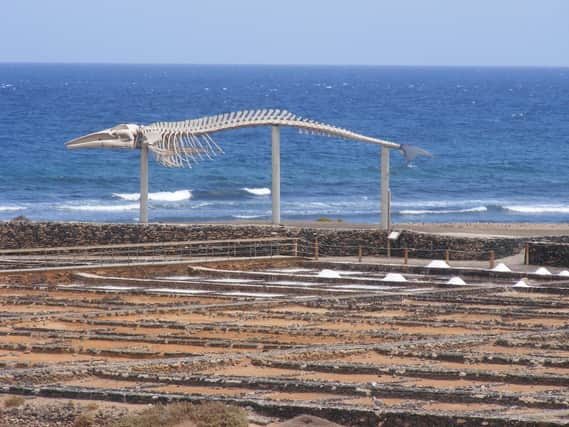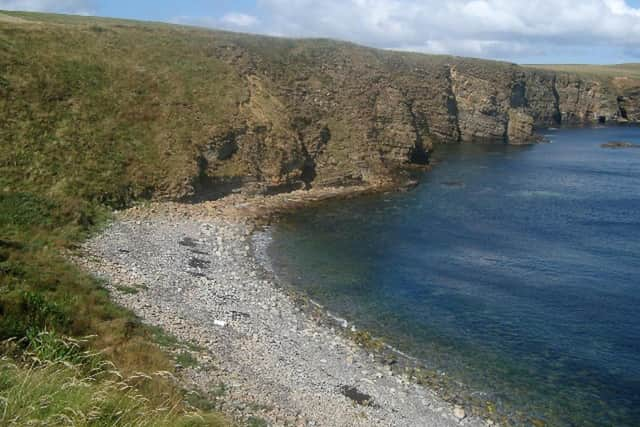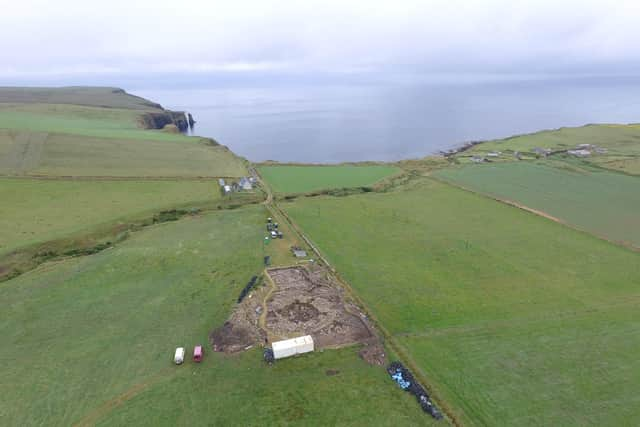DNA unlocks ancient tale of a giant whale and the end of an Orkney community


The relationship between whales and humans in the islands during the Iron Age has been illuminated in a facinating new study by University of Highlands and Islands Archaeology Institute and whale experts from North Carolina and Nova Sotia.
DNA analysis of a vast collection of whale bones found at the site of the Cairns Broch on South Ronaldsay found that 19 out of 33 came from a single fin whale, the second largest of the species.
Advertisement
Hide AdAdvertisement
Hide AdA number of the bones bore chop marks, indicating they had been butchered, while others showed singe marks from direct heat.


An excavation of the site found some of the bones were stuffed in walls of the broch – an Iron Age stone tower house – and others crushed in the rubble used to fill in the structure before it was left behind.
Intriguingly, a piece of vertebrae f was fashioned into a vessel and left just outside the broch door at the very end of its occupation. Inside were the remains of two new-born lambs and the jawbone of a human man. Resting by it were two red deer antlers.
Martin Carruthers, site director of The Cairns and UHI lecturer in archaeology, said the way the bones were left behind indicated an “act of closure” at the broch.


Mr Carruthers said: “It’s just amazing to be able to say with confidence that so many of these whale bones, including the vessel with the human jawbone, actually belong to the same animal, especially as we’ve ecovered them from the site over a number of different seasons, not knowing all along that the spread of bone belonged to one huge beast.
“One of the most important things, from my point of view, is how this research helps us to recognise the significant role that the treatment of the fin whale had in the dramatic procedures of deliberately ending of the monumental broch”.
Dr Vicki Szabo, of Western Carolina University, North Carolina and Dr Brenna Frasier of Saint Mary’s University, Nova Scotia, who have long investigated the role of the whale in North Atlantic Society, collaborated with Mr Carruthers on the research at Cairns Broch.
Mr Carruthers added: “We had some suspicions that something particularly interesting was going on with the amount of whale bone that was emerging from end of our broch, but we’d never have managed to get to this level of specificity without the input and collaboration with Brenna and Vicki”.
Advertisement
Hide AdAdvertisement
Hide AdLife at Cairns Broch came to an end during the 2nd Century AD, when many of high-walled towers, which are only found in Scotland, fell out of use.
Mr Carruthers said there was a sense that “things were changing” around this time and, while the stranding of the whale did not necessarily trigger the exodus from Cairns Broch, it may have enouraged it.
He said: “We may still wonder if occurrences, such as the stranding of a significantly large whale, might encourage a community, perhaps already considering a radical break with the past, to go for it.”
“There was a very practical bonus to be had in the harvesting of a very large whale, but we may also wonder if the appearance of such a large beast stranded on the foreshore meant more to Iron Age communities than just a resource.
“In many non-Western societies, and, indeed, many ancient European ones, sudden natural phenomena such as the highly prominent death of a significant type of animal may be seen as a conspicuous indication of arcane and esoteric forces, taken as a sign, an auspicious, or inauspicious, omen.
“Even though stranding may have been more common with a larger population of whales thought to exist in prehistory, it might be that both the practical impact, and the potential ideological and psychological effects of the appearance of a big stranded whale created the critical timing and final motivation for major change.”
The Fin whale can grow up to an incredible 27 metres long and reach top speeds of 45 kilometres per hour . It was not commonly hunted until the introduction of the explosive harpoon with it more likely to have been stranded at Windwick Bay on South Rondalsay, researchers believe.
The arrival of such a beast on the beach of South Ronaldsay would have afforded the community the change to acquire large volume of meat, oil for lighting lamps while the bone was turned into various objetcts, for the vessel found at the front door of the broch to tools – such as chopping boards and weaving batons – and construction materials, with large ribs used as roof rafters.
Advertisement
Hide AdAdvertisement
Hide AdThe stranding of a major animal, like a massive fin whale, would have represented a massive contribution to the community’s resources, Mr Carruthers said.
The level of high-protein food offered up by such as whale would likely have “energised” the community and led to a successful year, he added.
He said: “At The Cairns, this whale boon could have included support for a major undertaking such as ending the premier building, the broch, a structure that had dominated the local landscape and society for generations.
“It would have been no minor activity to demolish the upper parts of the massive and complex broch, and it is likely that the work of rendering it down would have had some serious consequences for the settlement, at the heart of which, lay the broch.
“It would have been a physically arduous and time-consuming process, probably involving many people, taking them away from other important tasks required of this busy farming group.”
Work continues at the Cairns Broch site to unearth further detail about the Iron Age community who lived there.
